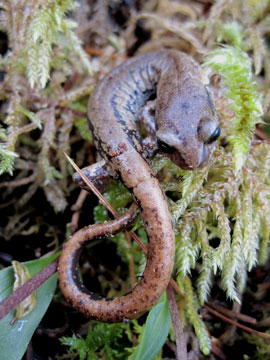Dead men tell no tales, but dead frogs can speak volumes. Scientists have shown that frogs and salamanders preserved in museums tell the history of a deadly fungus and its spread across Mexico and Central America. The new finding, published recently in the Proceedings of the National Academy of Sciences (PNAS), may help explain past and ongoing amphibian die-offs in the region.
About 40 percent of the world’s amphibian species are shrinking in number. In many locations, researchers cannot tie plummeting amphibian counts to obvious habitat destruction. Among the proposed causes for such “enigmatic decline” is the epidemic-like infection by the fungus Batrachochytrium dendrobatidis, or Bd. Bd invades the skin—through which amphibians absorb water and electrolytes—and can cause lethal chemical imbalance.
Graduate student Tina Cheng of San Francisco State University and colleagues sought evidence of past Bd infections in the rich database of amphibians floating in jars at the Museum of Vertebrate Zoology in Berkeley, Calif. They swabbed for Bd DNA on the skin of frogs and salamanders collected since the 1960s from three regions of enigmatic decline: the mountains of southern Mexico, those of western Guatemala, and the cloud forests of Monteverde, Costa Rica.
 The salamander Pseudoeurycea rex, once abundant in Guatemala and Mexico, is now classified as “critically endangered” on the International Union for Conservation of Nature Red List. Photo by: Tina Cheng |
In each region, the oldest samples to test positive for Bd coincided with the earliest field reports of amphibian deaths. For the first time, researchers could map the progressive emergence of Bd in Mexico, Guatemala, and Costa Rica to the sequential die-offs of amphibians recorded in those same regions. The fungus, it appears, marched southward across Central America during the 1970s and 1980s.
“I tried to go to the field to sample for the pathogen, but all the amphibians are gone,” said Cheng in an interview with mongabay.com. Her new method allows researchers to test animal species that have all but vanished.
“This is a huge breakthrough for us,” said Cheng, “to prove that molecular techniques that work on live animals can be used on preserved specimens, too.” Cheng will soon start a Ph.D. program in ecology at the University of California, Santa Cruz.
Genetic testing of museum specimens was once thought impossible, because many tissue preservatives degrade DNA. This study demonstrates that scientists can identify Bd by a tiny stretch of its genetic code, swiped from the skin, that survives chemical damage.
Cheng’s findings build on work by biologist Karen Lips of the University of Maryland, whose team predicted Bd’s arrival at its research site in El Copé, Panama. In September 2004, the frogs and salamanders Lips had studied for years began testing positive for the fungus and dying in staggering numbers, as reported in a 2006 paper.
“What we had seen going into the future, they found it going into the past,” ecologist James Collins of Arizona State University, a co-author of the earlier study, told mongabay.com. Extending the Bd timeline, said Collins, bolsters the argument that fungal outbreaks are driving a wave of amphibian declines across Central America.
Scientists are still trying to understand how Bd spreads, how to stop it, and how to treat infected animals. Joseph Mendelson, curator of herpetology at Zoo Atlanta, who was not associated with either study, told mongabay.com that DNA testing of museum specimens is a big advance.
“We can use their technique and really figure out from where this beast came,” Mendelson said, “and use that to inform our efforts to move forward.”
CITATION: Tina L. Cheng, Sean M. Rovito, David B. Wake, and Vance T. Vredenburg. Coincident mass extirpation of neotropical amphibians with the emergence of the infectious fungal pathogen Batrachochytrium dendrobatidis. Proceedings of the National Academy of Sciences, 7 June 2011. DOI: 10.1073/pnas.1105538108
Helen Shen is a graduate student in the Science Communication Program at the University of California, Santa Cruz.